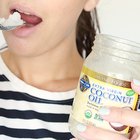
Despite the correlation between ultraviolet (UV) light exposure and increased skin cancer risk, tanning bed use to deepen skin color continues. Recent research suggests the practice affects more than just the skin. UV light exposure that occurs during tanning also elevates mood and may be addictive.
Tanning and Mood
Improved self-image is not the sole mood-elevating factor associated with tanning bed use. According to the American Academy of Dermatology Association, skin exposed to UV light produces and releases beta-endorphin. Beta-endorphin is an opium-like chemical best known for providing the sense of well-being, or “runners high," that accompanies vigorous exercise.
Vitamin D
According to an editorial published in the Journal of Psychiatry and Neuroscience, low levels of vitamin D have been associated with depression. UV light exposure from the sun or tanning beds stimulates the skin to produce vitamin D. The editorial also reports "exposure of skin to ultraviolet light, which converts cutaneous 7-dehydocholesterol to vitamin D3, is the most important source of vitamin D for most people".
Tanning Addiction
An editorial published in Expert Reviews supports the theory of a possible link between frequent tanning and UV light addiction. It references a study in which tanners were given naltrexone, an opioid-blocking substance, before UV radiation exposure. Fifty percent of frequent tanners experienced symptoms of withdrawal including nausea and jitters. Infrequent tanners experienced no withdrawal symptoms.
Related Articles

What Foods Provide Calcium D-Glucarate?

Can LED Light Get Rid of Brown Spots on ...

Skin Benefits of Eating Coconut Oil

What Are the Dangers of Fraxel Repair?

What Is the Initial Breakout From ...

How to Get a Base Tan in a Tanning Bed

Homeopathy Cure for Stretch Marks

The Effects of Inhaling Air Dusters

Traumatic Effects of a Bad Marriage on ...

How to Reduce Acne Inflammation

Estrogen in Skin Creams

Difference Between Bronzing & Tanning ...

How Does Brewer's Yeast Benefit Skin?

Benefits of Shea Butter and Coconut Oil ...

Silent Treatment Abuse

How to Start a Base Tan for Very Fair ...

Definition of Skin Bleaching

Olive Leaf Extract for Skin Problems

How to Deal With a Bipolar Woman

How to Make a Spray Tan Last
References
Writer Bio
Cynthia Ruscitto has been writing professionally since 2005. Her work has appeared on numerous health and anti-aging websites and blogs, such as WorldHealth, a site representing the American Academy of Anti-Aging Medicine. Ruscitto holds a Bachelor of Science in medical technology, and is a former clinical microbiologist and certified secondary education science teacher.
Photo Credits
tanning on sobe image by Wimbledon from Fotolia.com